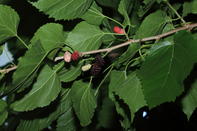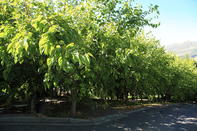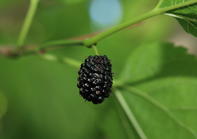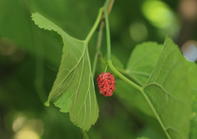Mulberries are thought to have originated in China, Japan and the Himalayan Foothills. The trees are primarily associated with sericulture (silk production), with China spinning silk from cocoons in the wild as far back as 4 500 years ago. Read more about sericulture here.

Mulberry trees have also long been treasured for their juicy fruit and medicinal properties. In Asia, farmers have long been using the leaves as animal feed, a practice that has spread to Africa, Latin and Central America, and the Caribbean since the late 1980s.
The wood is used to make furniture, woven baskets and even sports equipment in countries such as India with the bark of some of the varieties. Certain varieties are also used to make paper.
International Production
China has the largest area under mulberry production, followed by India. Small volumes are also produced in countries such as Thailand and Brazil.
Local Production

Various species have been introduced into South Africa from Indonesia, Thailand, and Taiwan since the 1600s. Attempts to start a silk industry started in 1726 when the Dutch East India Company brought silkworms into the country. Initially, silk was produced by slaves and there was even an attempt to establish a free slave sericulture project near Stellenbosch.
In 1881 a group of about thirty Italian sericulture specialists were brought to South Africa, to start a silk industry at Gouna near Knysna in the Western Cape. The immigrants were under the impression that they would be able to start farming right away, but on their arrival found there were not any mulberry trees in the Gouna forest. In the end, they had to revert to farming and woodcutting to survive. The mulberry trees they planted also did not last long because of unfavourable production conditions.
More recently in the 1980s, the Department of Agriculture launched a sericulture project in Mpumalanga, during which various trials were done on different mulberry tree species. The project was privatised in 1994 when the government stopped funding for the project because of the high costs and low returns.
Prof Kas Holtzhuasen, who pioneered the domestication and improvement of the Marula tree, is also seen as one of the pioneers of this project.
Production
Mulberries grow best in areas where there are no big fluctuations in temperature. They also require lots of water, so is best planted in areas with high rainfall.
The white mulberry is extremely invasive and may no longer be planted without a permit. Mulberry production is also highly labour intensive since all the berries have to be picked at exactly the right time. Production in effect is almost non-existent, with most of the supplies seen in shops being either imported or coming from a few trees that might still be surviving on local farms.
One of the only remaining sericulture farms in the country is located in Limpopo near Hoedspruit. This farm had roughly 6 ha under production in 2019, but all these trees are regularly pruned into shrubs, like in the song “Here We Go Round The Mulberry Bush” to ease management and harvesting. The trees in effect only produce small volumes of tiny fruit. The leaves are not only used as feed for the silkworms but also to feed pigs.
As stated by Africa Silk’s owner, Ronel Swart, no new trees have been planted since the farm was started in 1994 because of the invasive status of the trees.
Production Season

Mulberries are a summer fruit, with fruit ripening from late spring.
Varieties
A range of varieties exist. The primary varieties produced at Africa Silk is the Noi and Thai Sang, which have been imported from Thailand but also grows in Taiwan. The beauty of these varieties is that they do not produce lots of flowers and berries, so do not pose a threat to local flora.
They also produce the Waterkloof variety, which can be used to produce berries but they only produce small fruit because the trees are pruned to boost leaf and not berry production.
Sales

A few mulberries are sold in South Africa, with most of the available stock being imported or harvested from trees that are not being formally farmed.
Uses
Mulberries are a superfood, rich in vitamins, minerals, fibre, anti-inflammatories and antioxidants.
They may be enjoyed fresh, used in baked goods, frozen or processed to be used in desserts, juices, teas, yoghurts and jams. The silk protein is also used in the pharmaceutical, prosthetics and cosmetics industries.